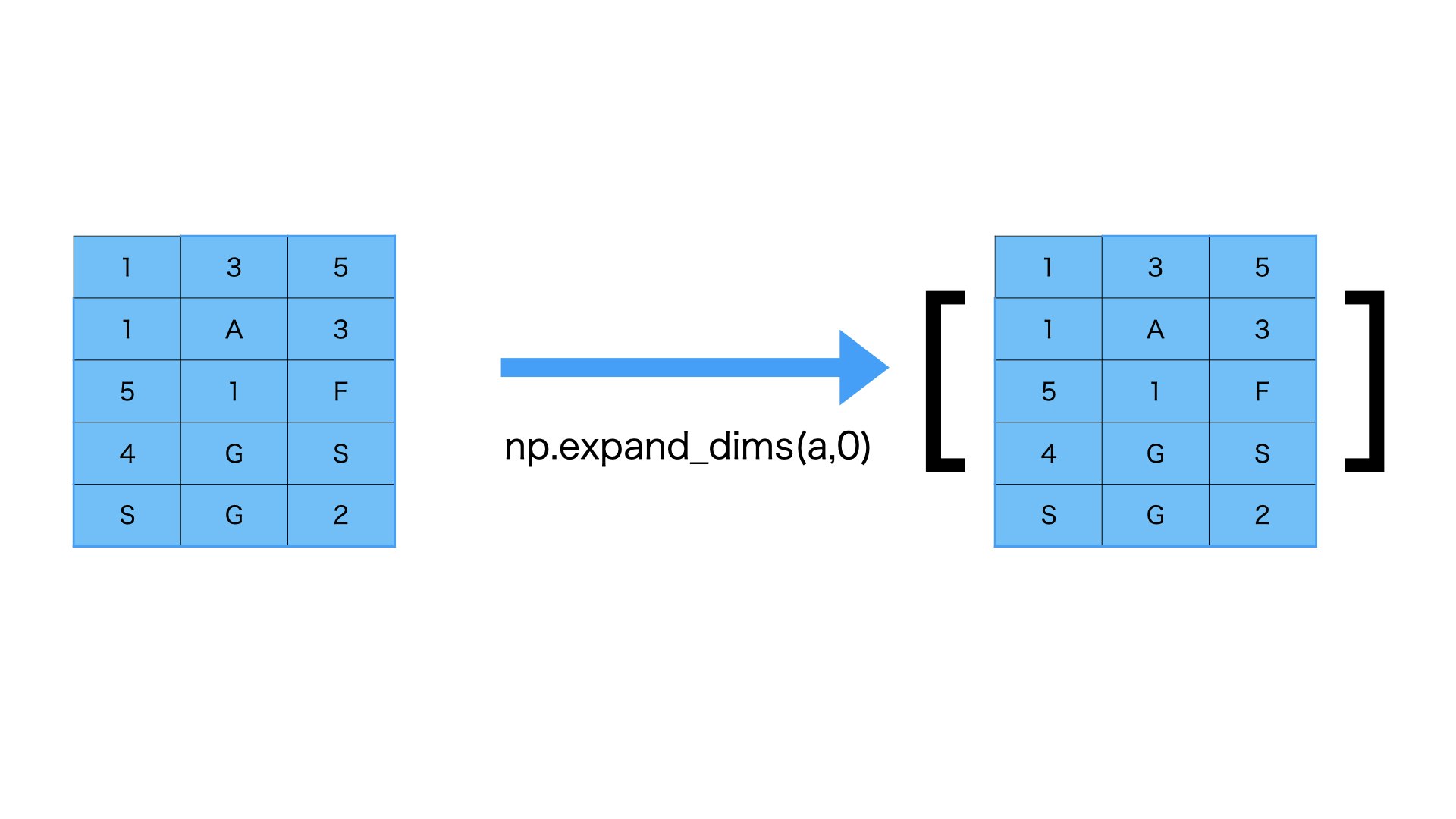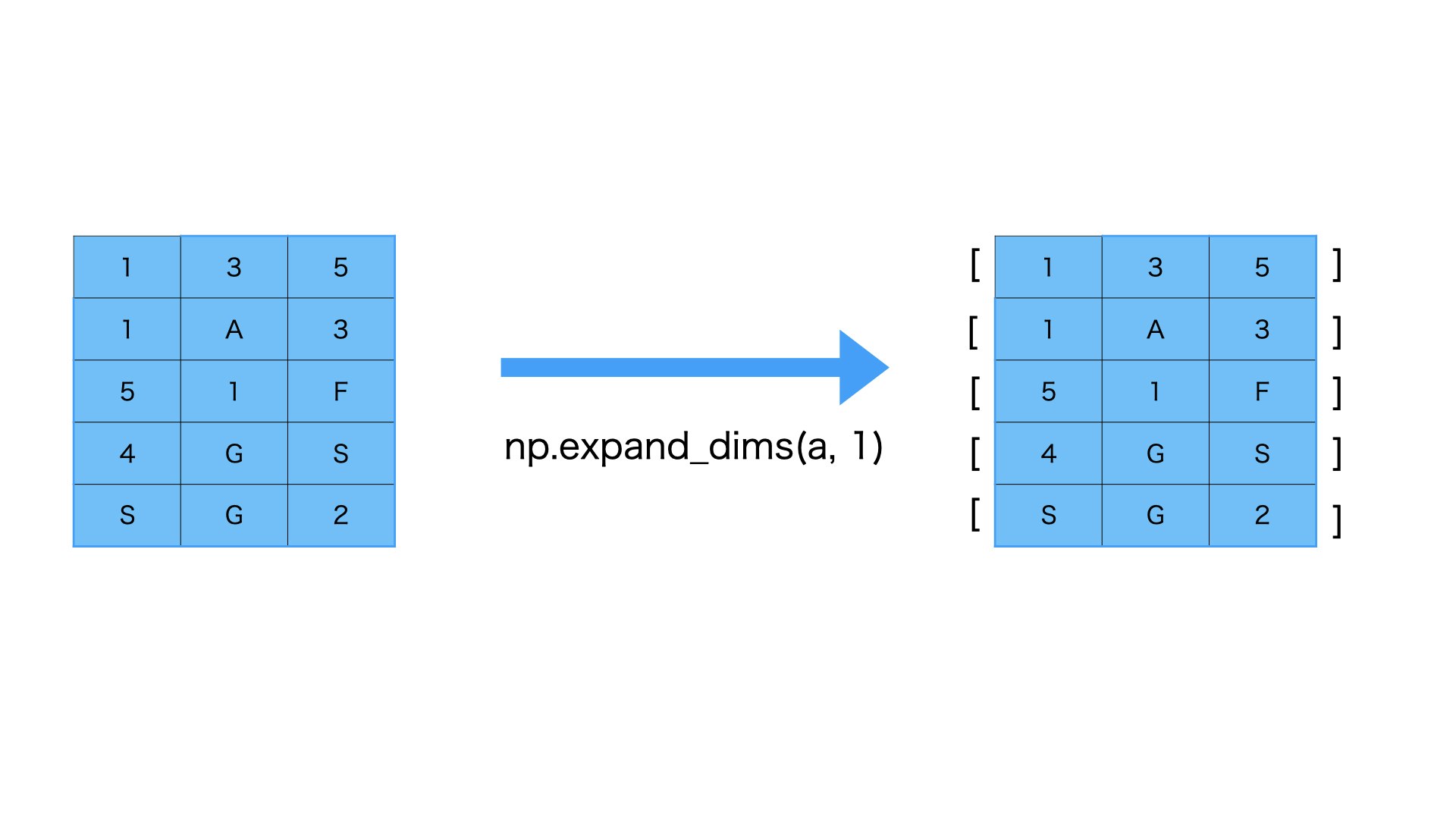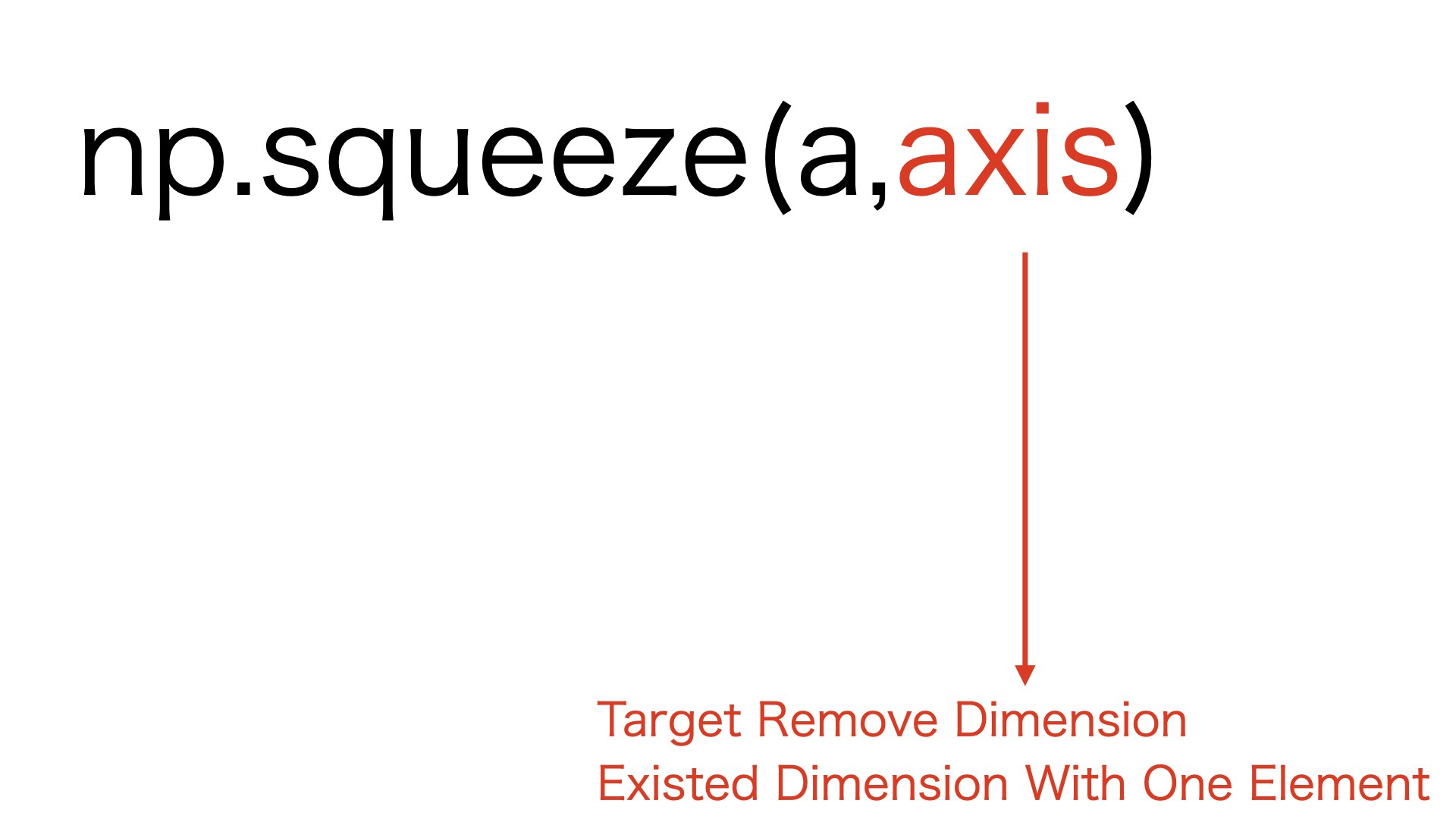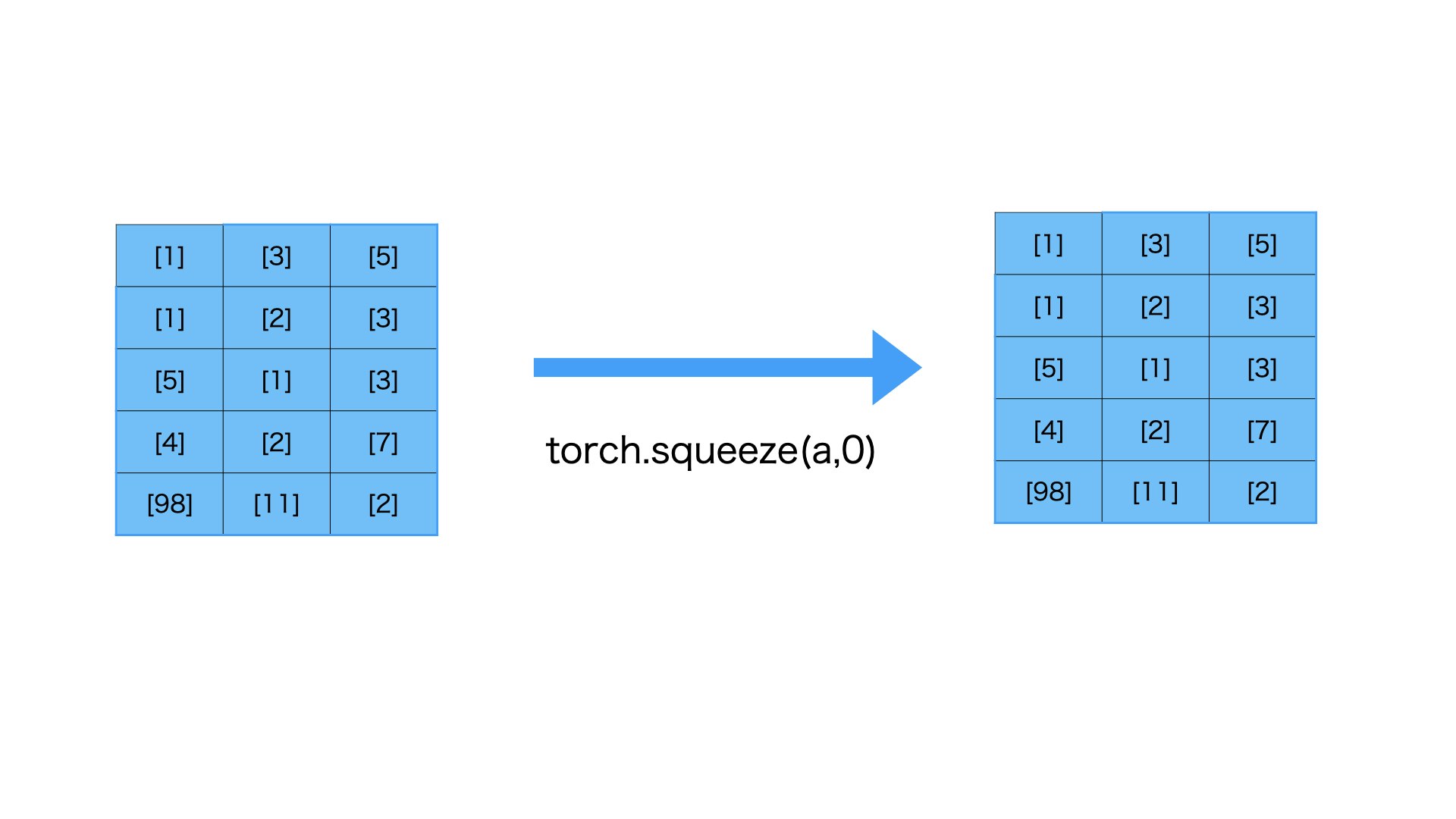背景###
numpyとpytorchには次元拡張と削減する方法は機械学習には頻繁に使われてます。今回は軽くそれを説明いたします。
次元拡張
np.expand_dims
torch.unsqueeze
次元縮小
np.squeeze
torch.squeeze
1.numpy###
1-1.np.expand_dims####
次元拡張
テストコード####
a = np.array([
[1, 3, 5],
[1, "A", 3],
[5, 1, "F"],
[4, "G", "S"],
["S", "G", 2]
])
print(a)
print("np.expand_dims(a, 0)")
b = np.expand_dims(a, 0)
print(b)
print("np.expand_dims(a, 1)")
b = np.expand_dims(a, 1)
print(b)
print("np.expand_dims(a, 2)")
b = np.expand_dims(a, 2)
print(b)
output####
[['1' '3' '5']
['1' 'A' '3']
['5' '1' 'F']
['4' 'G' 'S']
['S' 'G' '2']]
np.expand_dims(a, 0)
[[['1' '3' '5']
['1' 'A' '3']
['5' '1' 'F']
['4' 'G' 'S']
['S' 'G' '2']]]
np.expand_dims(a, 1)
[[['1' '3' '5']]
[['1' 'A' '3']]
[['5' '1' 'F']]
[['4' 'G' 'S']]
[['S' 'G' '2']]]
np.expand_dims(a, 2)
[[['1']
['3']
['5']]
[['1']
['A']
['3']]
[['5']
['1']
['F']]
[['4']
['G']
['S']]
[['S']
['G']
['2']]]
1-2.np.squeeze####
テストコード####
a = np.array([
[1, 3, 5],
[1, "A", 3],
[5, 1, "F"],
[4, "G", "S"],
["S", "G", 2]
])
print("a")
print(a)
print()
print("np.expand_dims(a,2)")
b = np.expand_dims(a,2)
print(b)
print()
print("c = np.squeeze(b,2)")
c = np.squeeze(b,2)
print(c)
print()
print("d = np.expand_dims(b,0)")
d = np.expand_dims(b,0)
print(d)
print()
print("e = np.squeeze(d,3)")
e = np.squeeze(d,3)
print(e)
output####
a
[['1' '3' '5']
['1' 'A' '3']
['5' '1' 'F']
['4' 'G' 'S']
['S' 'G' '2']]
np.expand_dims(a,2)
[[['1']
['3']
['5']]
[['1']
['A']
['3']]
[['5']
['1']
['F']]
[['4']
['G']
['S']]
[['S']
['G']
['2']]]
c = np.squeeze(b,2)
[['1' '3' '5']
['1' 'A' '3']
['5' '1' 'F']
['4' 'G' 'S']
['S' 'G' '2']]
d = np.expand_dims(b,0)
[[[['1']
['3']
['5']]
[['1']
['A']
['3']]
[['5']
['1']
['F']]
[['4']
['G']
['S']]
[['S']
['G']
['2']]]]
e = np.squeeze(d,3)
[[['1' '3' '5']
['1' 'A' '3']
['5' '1' 'F']
['4' 'G' 'S']
['S' 'G' '2']]]
2.torch###
2-1.torch.unsqueeze####
テストコード####
import torch
a = torch.tensor([
[1, 3, 5],
[1, 2, 3],
[5, 1, 3],
[4, 2, 7],
[98, 11, 2]
])
c0 = torch.unsqueeze(a, 0)
print(c0)
c1 = torch.unsqueeze(a, 1)
print(c1)
c2 = torch.unsqueeze(a, 2)
print(c2)
output####
tensor([[[ 1, 3, 5],
[ 1, 2, 3],
[ 5, 1, 3],
[ 4, 2, 7],
[98, 11, 2]]])
tensor([[[ 1, 3, 5]],
[[ 1, 2, 3]],
[[ 5, 1, 3]],
[[ 4, 2, 7]],
[[98, 11, 2]]])
tensor([[[ 1],
[ 3],
[ 5]],
[[ 1],
[ 2],
[ 3]],
[[ 5],
[ 1],
[ 3]],
[[ 4],
[ 2],
[ 7]],
[[98],
[11],
[ 2]]])
2-2.torch.squeeze####
テストコード####
import torch
a = torch.tensor([
[[1], [3], [5]],
[[1], [2], [3]],
[[5], [1], [3]],
[[4], [2], [7]],
[[98], [11], [2]]
])
print("torch.squeeze(a, 0)")
c0 = torch.squeeze(a, 0)
print(c0)
print()
print("torch.squeeze(a, 1)")
c1 = torch.squeeze(a, 1)
print(c1)
print()
print("torch.squeeze(a, 2)")
c2 = torch.squeeze(a, 2)
print(c2)
output####
torch.squeeze(a, 0)
tensor([[[ 1],
[ 3],
[ 5]],
[[ 1],
[ 2],
[ 3]],
[[ 5],
[ 1],
[ 3]],
[[ 4],
[ 2],
[ 7]],
[[98],
[11],
[ 2]]])
torch.squeeze(a, 1)
tensor([[[ 1],
[ 3],
[ 5]],
[[ 1],
[ 2],
[ 3]],
[[ 5],
[ 1],
[ 3]],
[[ 4],
[ 2],
[ 7]],
[[98],
[11],
[ 2]]])
torch.squeeze(a, 2)
tensor([[ 1, 3, 5],
[ 1, 2, 3],
[ 5, 1, 3],
[ 4, 2, 7],
[98, 11, 2]])
まとめ###
次元拡張
np.expand_dims -> torch.unsqueeze
次元縮小
np.squeeze -> torch.squeeze

















